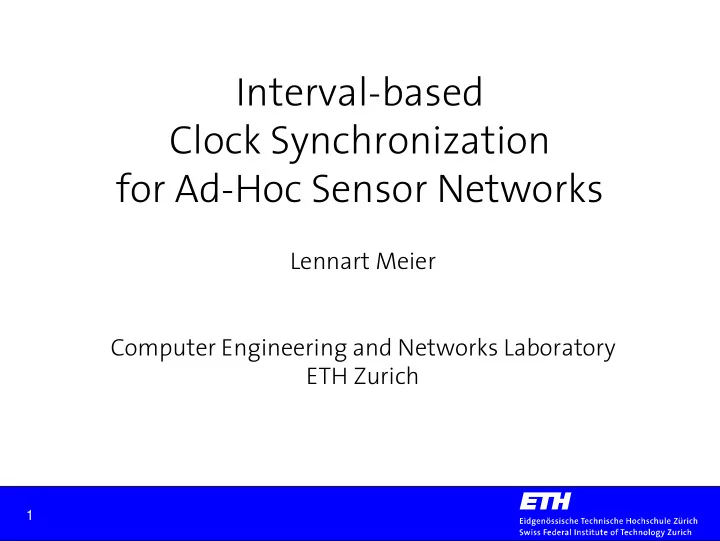

Interval-based Clock Synchronization for Ad-Hoc Sensor Networks Lennart Meier Computer Engineering and Networks Laboratory ETH Zurich 1
Motivation message-delay uncertainty specific communication pattern for synchronization clock drift 1 3 sensor nodes sensing areas 5 dynamic structures 4 2 2
Related Work • Clustering • J. Elson, L. Girod, and D. Estrin. Fine-grained network time synchronization using reference broadcasts. In Proceedings of the Fifth Symposium on Operating Systems Design and Implementation (OSDI 2002) , 2002. • Tree construction • S. Ganeriwal, R. Kumar, and M. B. Srivastava. Timing-sync protocol for sensor networks. In Proceedings of the First ACM Conference on Embedded Networked Sensor Systems (SenSys) , 2003. • M. L. Sichitiu and C. Veerarittiphan. Simple, accurate time synchronization for wireless sensor networks. In IEEE Wireless Communications and Networking Conference (WCNC’03) , 2003. • J. van Greunen and J. Rabaey. Lightweight time synchronization for sensor networks. In 2nd ACM International Conference on Wireless Sensor Networks and Applications , pages 11–19, 2003. 3
Overview • Goal: Synchronization in ad-hoc sensor networks with arbitrary communication patterns. • Claim: Interval-based synchronization is particularly suited. • Recent results on interval-based synchronization. 4
Interval-Based Synchronization of Drift-Constraint Clocks K. Marzullo and S. Owicki: Maintaining the Time in a Distributed System , PODC 1983. 5
Advantages of Interval-Based Synchronization ptimal combination of time information. o particular communication pattern. uaranteed bounds on fused sensor data. • Concerted actions guaranteed to succeed. 6
Internal Synchronization Instantaneous message exchange. No delay uncertainty. K. Römer, Time Synchronization in Ad Hoc Networks , MobiHoc 2001. 7
Recent Results: Improved Synchronization • Simply intersecting current bounds is worst-case-optimal. • In the average case, previous bounds (the “back path”) enhance synchronization. P. Blum, L. Meier, and L. Thiele: Improved Interval-Based Clock Synchronization in Sensor Networks , IPSN'04. N 3 N 2 N 5 N 5 N 3 h 3 ( t a ) h 2 ( t c ) h h 5 ( t b ) h 5 ( t a ) h 3 ( t c ) 8 N 1 N 2 N
Recent Results: Improved Synchronization P. Blum, L. Meier, and L. Thiele: Improved Interval-Based Clock Synchronization in Sensor Networks , IPSN'04. 9
Recent Results: Optimal Synchronization • Arbitrary scenarios: traverse all paths and choose best bounds. • No algorithm can do better. • Need to store and exchange complete histories of all nodes. L. Meier, P. Blum, and L. Thiele: Internal Synchronization of Drift-Constraint Clocks in Ad-Hoc Sensor N 3 N 2 Networks , MobiHoc 2004. N 5 N 5 N 3 h 3 ( t a ) h 2 ( t c ) h h 5 ( t b ) h 5 ( t a ) h 3 ( t c ) 10 N 1 N 2 N
Is it practical? • The optimal algorithm is too expensive. • Trade off history size vs. synchronization quality. • Store only recent events. 11
Conclusion Interval-based synchronization • needs no particular communication pattern • provides guaranteed bounds on fused data • guarantees success of concerted actions • and hence is particularly suited for ad-hoc sensor networks. 12
Open Questions • Ideal history size. • Mobile nodes. • Node density and connectivity. • Faulty or misbehaving nodes. 13
Thank you. Interval-based Clock Synchronization for Ad-Hoc Sensor Networks Lennart Meier Computer Engineering and Networks Laboratory ETH Zurich 14
Recommend
More recommend